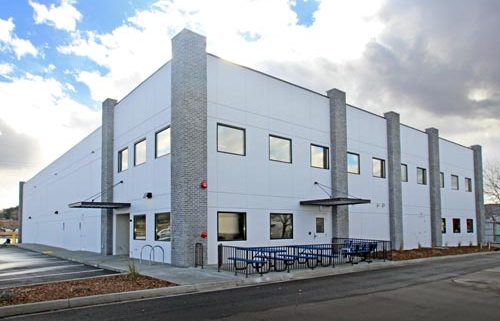The Science Behind Tilt-Up Construction for Industrial Buildings
In tilt-up construction, builders cast concrete panels on-site and then tilt them into place. This technique is prevalent for industrial buildings due to its efficiency and cost-effectiveness. Understanding the science behind tilt-up construction involves examining its process, suitability, advantages, and comparative cost.
What is Tilt-Up Construction?
Tilt-up construction involves casting concrete panels horizontally on the building’s floor slab. Once the panels have cured, they are lifted, or “tilted,” into their final vertical positions. This process uses a crane or other lifting equipment to place the panels. The panels are then secured with steel reinforcements and connected to the foundation.

Ideal Project Types
Tilt-up construction is particularly suited to large-scale industrial buildings such as warehouses, distribution centers, and manufacturing plants. It is advantageous for projects requiring large, open interior spaces and where rapid construction is beneficial. The method supports wide spans and can accommodate significant loads, making it ideal for heavy-duty industrial uses.
Differences from Other Construction Methods
Unlike traditional masonry or precast concrete construction, tilt-up construction involves casting panels on-site rather than off-site. In traditional masonry, walls are built brick by brick, which can be time-consuming. Precast concrete panels, in contrast, are cast in a factory and transported to the site, often involving complex logistics and transportation challenges.
Advantages of Tilt-Up Construction
- Cost-Effectiveness: Tilt-up construction is often less expensive than other methods. By casting panels on-site, it reduces transportation costs and minimizes material waste. Studies show that tilt-up construction can save up to 10-20% in construction costs compared to other methods (source: Tilt-Up Concrete Association).
- Speed of Construction: The process can be faster due to simultaneous site preparation and panel casting. Consequently, once you cast the panels, you can erect them quickly, which shortens the overall construction timeline.
- Durability: Concrete panels provide excellent durability and resistance to severe weather conditions. They offer good thermal insulation and can contribute to lower energy costs over time.
- Design Flexibility: Tilt-up construction allows for various architectural styles and designs. As a result, you can finish panels with different textures and colors to meet aesthetic requirements.
Disadvantages of Tilt-Up Construction
- Initial Costs: While generally cost-effective, the initial setup for tilt-up construction, including formwork and equipment, can be high. This upfront cost may not be justified for smaller projects.
- Space Requirements: Adequate space is necessary for casting panels and maneuvering lifting equipment. This requirement might limit the method’s applicability in densely built urban areas.
- Weather Dependency: The curing process of concrete panels depends on weather conditions. Extreme temperatures or adverse weather can delay the construction schedule.
Cost Comparison
Tilt-up construction typically offers lower costs compared to other methods. According to the Tilt-Up Concrete Association, projects using tilt-up construction can be 10-15% less expensive than conventional masonry and up to 20% cheaper than some precast concrete methods. These savings stem from reduced labor costs and lower transportation expenses.
Conclusion
Tilt-up construction is a practical and economical choice for industrial buildings. Its ability to deliver large, durable structures quickly and cost-effectively makes it a preferred method for many industrial projects. However, the design team must evaluate considerations such as initial setup costs and space requirements. Comparing costs and benefits against other construction methods can help determine the best approach for specific project needs. By understanding these factors, stakeholders can make informed decisions about whether tilt-up construction aligns with their project goals and constraints.
References
- Tilt-Up Concrete Association. (n.d.). Benefits of Tilt-Up Construction. Retrieved from Tilt-Up Concrete Association
- Concrete Construction. (2021). Tilt-Up Construction: Cost-Effective and Efficient. Retrieved from Concrete Construction








